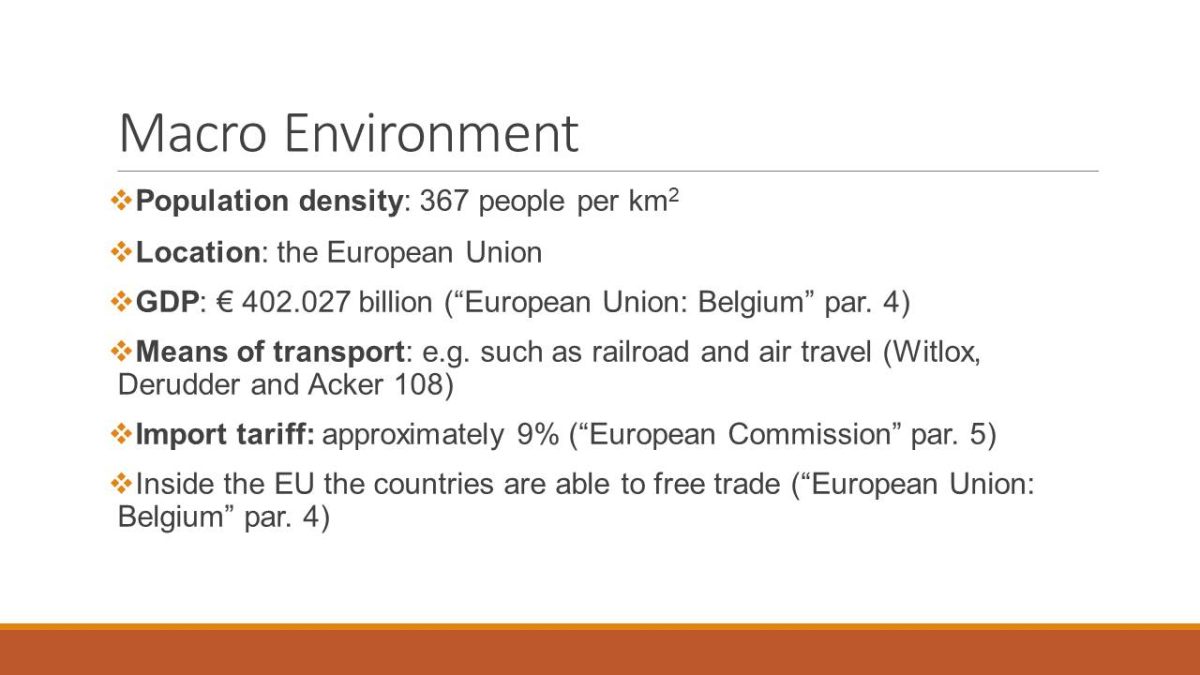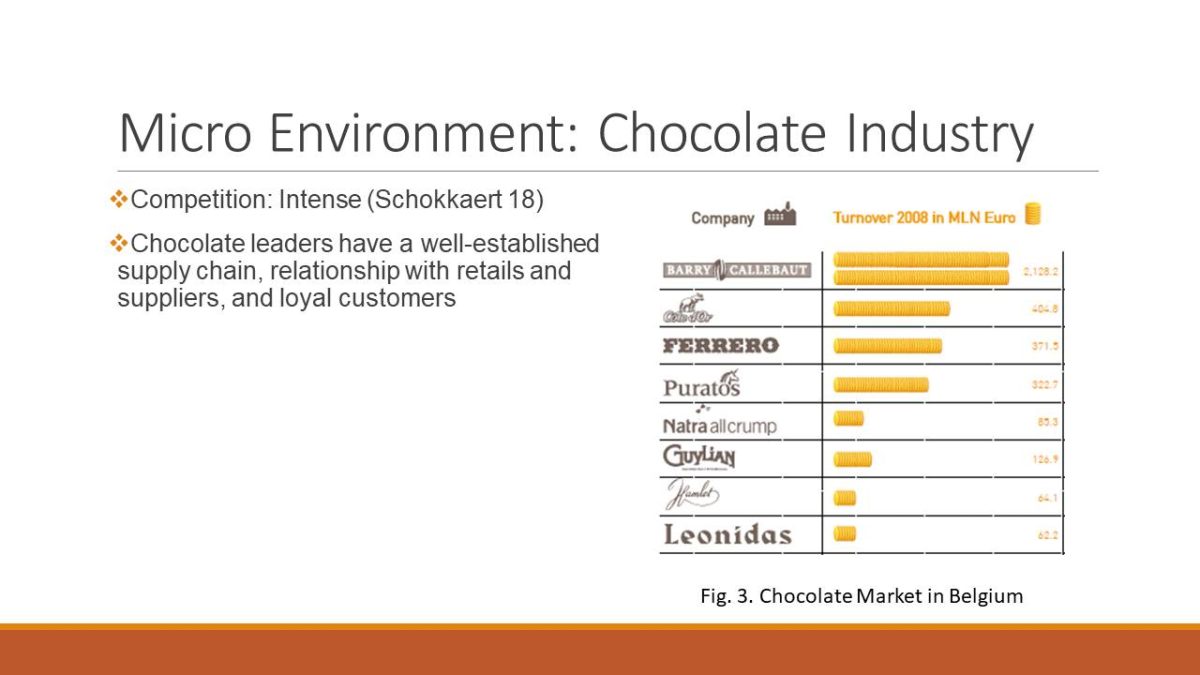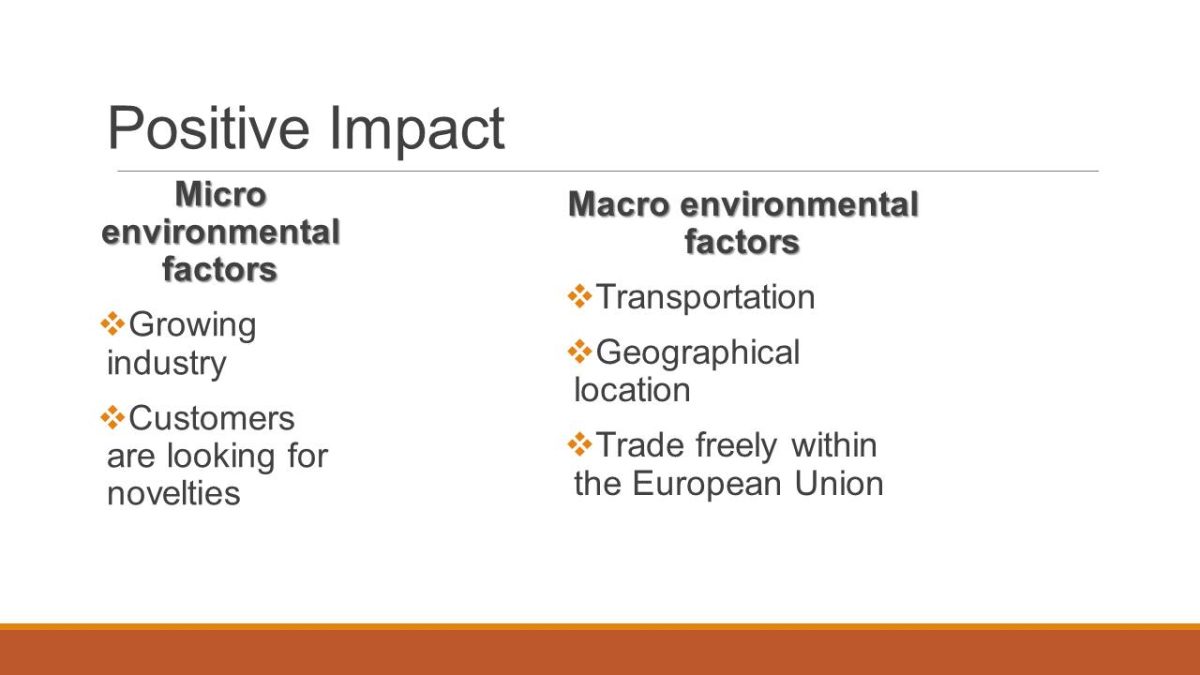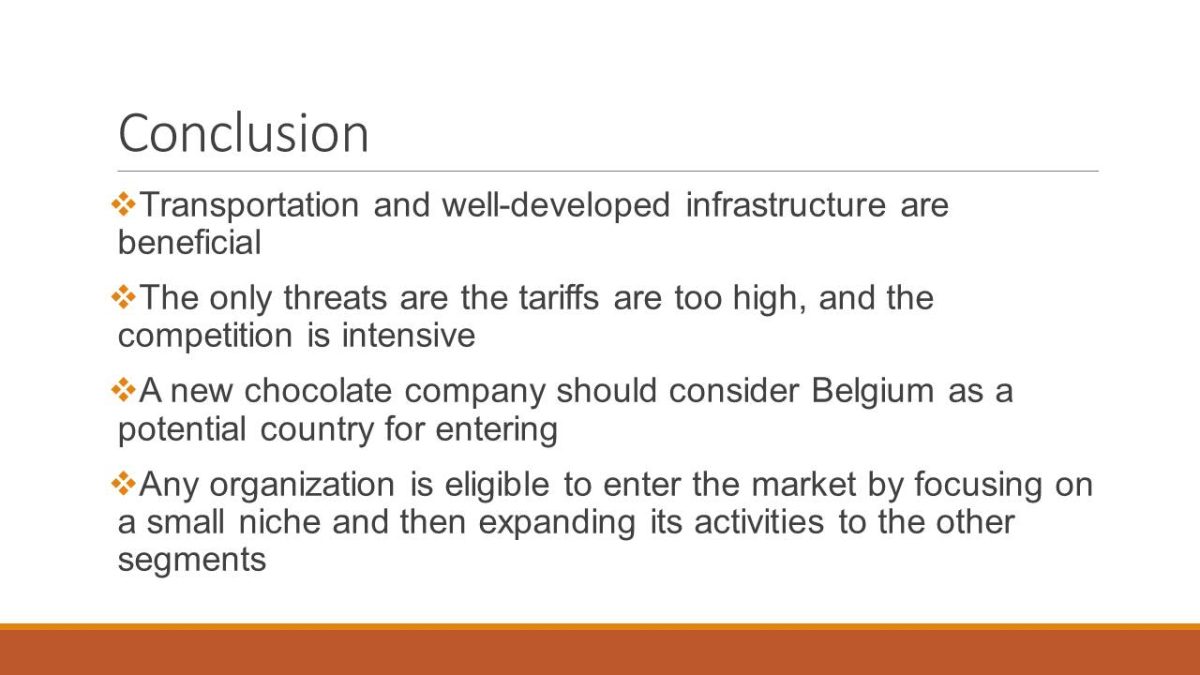General facts
- Brussels is the capital;
- Dutch, French, and German are official languages;
- Belgium is part of the EU;
- Population 11 203 992 people (“European Union: Belgium” par. 4);
- Its square is 30 528 km2 (par. 4);
- GDP is € 402.027 billion (par. 4);
- Leader in the chocolate industry (Inkpen and Ramaswamy 37).
Some general facts about Belgium will be discussed, as they help get a clear presentation about the country. Belgium’s capital is Brussels. Belgium is a part of European Union and has three official languages, French, Dutch, and German. Its population is 11 203 992 people, and its square is 30 528 km2 (“European Union: Belgium” par. 4). Consequently, it could be noticed the population density is not very high. As for the GDP, it is € 402.027 billion, and it uses the euro as a currency, as it is a part of the European Union (“European Union: Belgium” par. 4). Moreover, Belgium is a world leader in the chocolate production (Inkpen and Ramaswamy 37). Consequently, this industry brings the majority of the income to the government and helps the country stay well known on the global market.

Macro Environment
- Population density: 367 people per km2;
- Location: the European Union;
- GDP: € 402.027 billion (“European Union: Belgium” par. 4);
- Means of transport: e.g. such as railroad and air travel (Witlox, Derudder and Acker 108);
- Import tariff: approximately 9% (“European Commission” par. 5);
- Inside the EU the countries are able to free trade (“European Union: Belgium” par. 4).
Some of the elements of the macro environment, such as demographics, location, and GDP were discussed on the previous slides. Nonetheless, the population density was calculated. Moreover, Belgium utilizes all the possible means of transport such as air travel and railroad and has well-developed transport infrastructure (Witlox, Derudder and Acker 108). Moreover, the government pays close attention to the continuous enhancement of these facilities. As for the tariffs, the system is rather complex, as for the chocolate import to Belgium, the tariff is approximately 9% (“European Commission” par. 5). However, the tariff will rise if more goods are imported. Nonetheless, if the company is established and registered in Belgium, it can trade freely, as Belgium is a country of the Eurozone (“European Union: Belgium” par. 4).

Micro Environment: Chocolate Industry
- Competition: Intense (Schokkaert 18);
- Chocolate leaders have a well-established supply chain, relationship with retails and suppliers, and loyal customers.

The microenvironment for the chocolate industry will be evaluated, as it is not possible to access the potential of all the industries. The competition is intense, as the company’s such as Barry Callebaut, Cote d’Or, and Ferrero have a well-established image in the country (Schokkaert 18). It is apparent that they have a well-established supply chain, relationship with retails and suppliers, and loyal customers.

Negative Impact
Micro environmental factors
- High competition;
- Loyal customers;
- High recognition.
Macro environmental factors
- Small demographic density;
- High tariffs.
After the description of micro and macro factors, the negative effect of the micro and macro factors will be described on this slide. Small demographic density has an adverse impact on the potential opportunities of the business, as there is a little change that people would be interested in new products. Moreover, the tariffs are high, and it decrease the amount of possible revenue. As for the microenvironment, the chocolate industry is highly occupied by the chocolate giants. Moreover, the companies have recognition and loyal clientele. Consequently, the entry barriers are rather high to enter and remain competitive on the market.

Positive Impact
Micro environmental factors
- Growing industry;
- Customers are looking for novelties.
Macro environmental factors
- Transportation;
- Geographical location;
- Trade freely within the European Union.
As for the positive influences, transportation will enhance the logistics, and the geographical location will encourage and benefit the export to the other European countries. Moreover, if the company will be established in Belgium, it will be able to trade freely within the EU. This fact will help the company enhance its operational performance and export activities. Lastly, high popularity of the chocolate industry is also beneficial, as it continuously evolving. The demand is growing, and customers are looking for novelties. Consequently, this matter can also be considered as a primary advantage for a new company.

Conclusion
- Transportation and well-developed infrastructure are beneficial.
- The only threats are the tariffs are too high, and the competition is intensive.
- A new chocolate company should consider Belgium as a potential country for entering.
- Any organization is eligible to enter the market by focusing on a small niche and then expanding its activities to the other segments.
In conclusion, it could be said that Belgium market has some threats and opportunities. However, it is apparent that transportation and well-developed infrastructure will allow development of new business. It might seem that the tariffs are too high, and the competition is intensive. However, these factors are the only threats for an entrant. A new chocolate company should consider Belgium as a potential country for entering, as the opportunities for the future advancement outweigh risks and difficulties. Any organization is eligible to enter the market by focusing on a small niche and then expanding its activities to the other segments.

Works Cited
“Belgian Chocolate” 2008. JPEG file. Web.
“Belgian Map” 2015. JPEG file. Web.
“Chocolate Market in Belgium” 2008. JPEG file. Web.
European Commission: Taxation and Custom Union 2015. Web.
European Union: Belgium 2015. Web.
Inkpen, Andrew, and Kannan Ramaswamy. Global Strategy: Creating and Sustaining the Advantage across Borders, Oxford: Oxford University Press, 2006. Print.
Schokkaert, Ben 2010. The Belgian Chocolate Sector. PDF file. Web.
Witlox, Frank, Ben Derruder and Veronique Acker. “Transport Geography in Belgium.” Journal of Transport Geography 29 (2013): 108-110. Print.